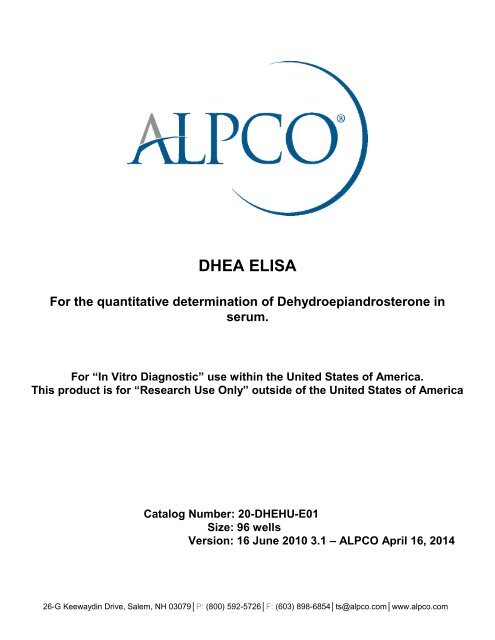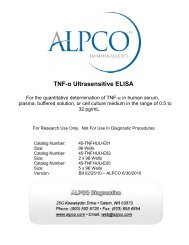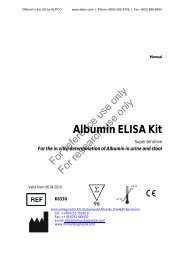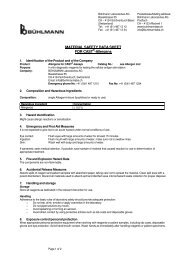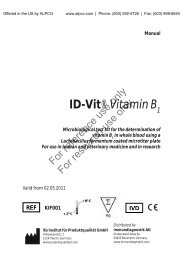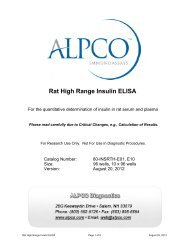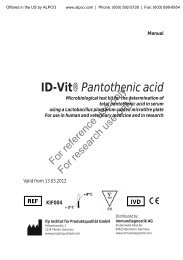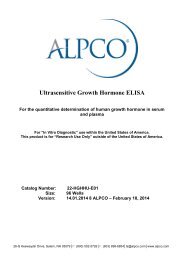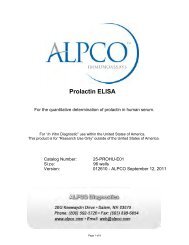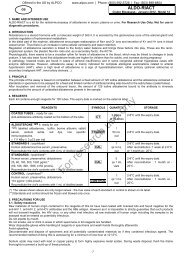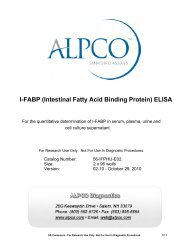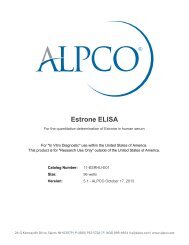DHEA ELISA - ALPCO Diagnostics
DHEA ELISA - ALPCO Diagnostics
DHEA ELISA - ALPCO Diagnostics
You also want an ePaper? Increase the reach of your titles
YUMPU automatically turns print PDFs into web optimized ePapers that Google loves.
<strong>DHEA</strong> <strong>ELISA</strong><br />
For the quantitative determination of Dehydroepiandrosterone in<br />
serum.<br />
For “In Vitro Diagnostic” use within the United States of America.<br />
This product is for “Research Use Only” outside of the United States of America<br />
Catalog Number: 20-DHEHU-E01<br />
Size: 96 wells<br />
Version: 16 June 2010 3.1 – <strong>ALPCO</strong> April 16, 2014<br />
26-G Keewaydin Drive, Salem, NH 03079│P: (800) 592-5726│F: (603) 898-6854│ts@alpco.com│www.alpco.com
Introduction<br />
Intended Use<br />
The <strong>DHEA</strong> <strong>ELISA</strong> is an enzyme immunoassay for the quantitative in vitro diagnostic measurement of<br />
Dehydroepiandrosterone (<strong>DHEA</strong>) in serum.<br />
Summary and Explanation<br />
Dehydroepiandrosterone (<strong>DHEA</strong>; androstenolone; 3-hydroxy-5-androsten-17-one) is a C 19 steroid produced<br />
in the adrenal cortex and, to a lesser extent, gonads. <strong>DHEA</strong> serves as a precursor in testosterone and<br />
estrogen synthesis. Due to the presence of a 17-oxo (rather than hydroxyl) group, <strong>DHEA</strong> has relatively weak<br />
androgenic activity, which has been estimated at ~10% that of testosterone. However in neonates,<br />
peripubertal children and in adult women, circulating <strong>DHEA</strong> levels may be several-fold higher than<br />
testosterone concentrations, and rapid peripheral tissue conversion to more potent androgens<br />
(androstenedione and testosterone) and estrogens may occur. Moreover, <strong>DHEA</strong> has relatively low affinity for<br />
sex-hormone binding globulin. These factors may enhance the physiologic biopotency of <strong>DHEA</strong>.<br />
The physiologic role of <strong>DHEA</strong> has not been conclusively defined. A variety of in vitro effects, including<br />
antiproliferative effects in different cell lines and effects on enzyme-mediated cell metabolism, have been<br />
reported. In vivo studies suggest that <strong>DHEA</strong> may affect cholesterol and lipid metabolism, insulin sensitivity and<br />
secretion and immune function. Abnormal <strong>DHEA</strong> levels have been reported in schizophrenia and obesity.<br />
Therapeutic administration of <strong>DHEA</strong> has been proposed for several conditions, including obesity and<br />
cardiovascular disease.<br />
Serum <strong>DHEA</strong> levels are relatively high in the fetus and neonate, low during childhood, and increase during<br />
puberty. Increased levels of <strong>DHEA</strong> during adrenarche may contribute to the development of secondary sexual<br />
hair. Serum <strong>DHEA</strong> levels progressively decline after the third decade of life. No consistent changes in serum<br />
<strong>DHEA</strong> levels occur during the menstrual cycle or pregnancy; however, parity may lower serum <strong>DHEA</strong> levels in<br />
premenopausal women.<br />
<strong>DHEA</strong> has a rapid metabolic clearance rate as compared to its sulfated conjugate, <strong>DHEA</strong>-S. Because of this,<br />
serum <strong>DHEA</strong> levels are 100-1000 fold lower than <strong>DHEA</strong>-S levels. In addition, serum <strong>DHEA</strong> levels show<br />
significant diurnal variation which is dependent on adrenocorticotrophic hormone (ACTH). Serum <strong>DHEA</strong> levels<br />
increase in response to exogenous ACTH administration.<br />
Measurement of serum <strong>DHEA</strong> is a useful marker of adrenal androgen synthesis. Abnormally low levels may<br />
occur in hypoadrenalism, and elevated levels occur in several conditions; including virilizing adrenal adenoma<br />
and carcinoma, 21-hydroxylase and 3-hydroxysteroid dehydrogenase deficiencies and in some cases of<br />
female hirsutism. Since very little <strong>DHEA</strong> is produced by the gonads, measurement of <strong>DHEA</strong> levels may aid in<br />
the localization of androgen source in virilizing conditions.<br />
PRINCIPLE of the test<br />
The <strong>DHEA</strong> <strong>ELISA</strong> Kit is a solid phase enzyme-linked immunosorbent assay (<strong>ELISA</strong>), based on the principle of<br />
competitive binding.<br />
The microtiter wells are coated with a polyclonal antibody directed towards an antigenic site on the <strong>DHEA</strong><br />
molecule. Endogenous <strong>DHEA</strong> of a patient sample competes with a <strong>DHEA</strong>-horseradish peroxidase conjugate<br />
for binding to the coated antibody. After incubation the unbound conjugate is washed off.<br />
The amount of bound peroxidase conjugate is inversely proportional to the concentration of <strong>DHEA</strong> in the<br />
sample. After addition of the substrate solution, the intensity of colour developed is inversely proportional to<br />
the concentration of <strong>DHEA</strong> in the patient sample.<br />
2
Precautions<br />
This kit is for in vitro diagnostic use only.<br />
For information on hazardous substances included in the kit please refer to Material Safety Data Sheets.<br />
All reagents of this test kit which contain human serum or plasma have been tested and confirmed negative<br />
for HIV I/II, HBsAg and HCV by FDA approved procedures. All reagents, however, should be treated as<br />
potential biohazards in use and for disposal.<br />
Avoid contact with Stop Solution containing 0.5 M H 2SO 4. It may cause skin irritation and burns.<br />
Never pipet by mouth and avoid contact of reagents and specimens with skin and mucous membranes.<br />
Do not smoke, eat, drink or apply cosmetics in areas where specimens or kit reagents are handled.<br />
Wear disposable latex gloves when handling specimens and reagents. Microbial contamination of reagents<br />
or specimens may give false results.<br />
Handling should be in accordance with the procedures defined by an appropriate national biohazard safety<br />
guideline or regulation.<br />
Do not use reagents beyond expiry date as shown on the kit labels.<br />
All indicated volumes have to be performed according to the protocol. Optimal test results are only obtained<br />
when using calibrated pipettes and microtiterplate readers.<br />
Do not mix or use components from kits with different lot numbers. It is advised not to exchange wells of<br />
different plates even of the same lot. The kits may have been shipped or stored under different conditions<br />
and the binding characteristics of the plates may result slightly different.<br />
Chemicals and prepared or used reagents have to be treated as hazardous waste according the national<br />
biohazard safety guideline or regulation.<br />
Safety Data Sheets for this product are available upon request directly.<br />
The Safety Data Sheets fit the demands of: EU-Guideline 91/155 EC.<br />
Kit Components<br />
Contents of the Kit<br />
1. Microtiterwells, 12x8 (break apart) strips, 96 wells;<br />
Wells coated with a anti-<strong>DHEA</strong> antibody (polyclonal).<br />
2. Standard (Standard 0-5), 6 vials, 1 mL, ready to use;<br />
Concentrations: 0 – 0.37 – 1.1 – 3.3 – 10 – 30 ng/mL<br />
Conversion: ng/mL x 3.467 = nmol/L<br />
contain 0.03% Proclin 300 + 0.005% gentamicin sulfate as preservative.<br />
3. Enzyme Conjugate, 1 vial, 14 mL, ready to use;<br />
<strong>DHEA</strong> conjugated to horseradish Peroxidase;<br />
* contain 0.03% Proclin 300, 0.015% BND and 0.010% MIT as preservative.<br />
4. Substrate Solution, 1 vial, 14 mL, ready to use;<br />
Tetramethylbenzidine (TMB).<br />
5. Stop Solution, 1 vial, 14 mL, ready to use;<br />
contains 0.5M H 2SO 4.<br />
Avoid contact with the stop solution. It may cause skin irritations and burns.<br />
6. Wash Solution, 1 vial, 30 mL (40X concentrated);<br />
see „Preparation of Reagents“.<br />
* BND = 5-bromo-5-nitro-1,3-dioxane<br />
MIT = 2-methyl-2H-isothiazol-3-one<br />
3
Note: Additional Standard 0 for sample dilution is available upon request.<br />
Equipment and material required but not provided<br />
A microtiter plate calibrated reader (450±10 nm), (e.g. the Instruments Microtiter Plate Reader).<br />
Calibrated variable precision micropipettes.<br />
Absorbent paper.<br />
Aqua dest.<br />
Storage and stability of the Kit<br />
When stored at 2-8°C unopened reagents will retain reactivity until expiration date. Do not use reagents<br />
beyond this date.<br />
Opened reagents must be stored at 2-8°C. Microtiter wells must be stored at 2-8°C. Once the foil bag has<br />
been opened, care should be taken to close it tightly again.<br />
Opened kits retain activity for six weeks if stored as described above.<br />
Preparation of Reagents<br />
Allow all reagents and required number of strips to reach room temperature prior to use.<br />
Wash Solution<br />
Add deionized water to the 40X concentrated Wash Solution.<br />
Dilute 30 mL of concentrated Wash Solution with 1170 mL deionized water to a final volume of 1200 mL.<br />
The diluted Wash Solution is stable for 2 weeks at room temperature.<br />
Disposal of the Kit<br />
The disposal of the kit must be made according to the national regulations. Special information for this product<br />
is given in the Material Safety Data Sheets (see chapter 13).<br />
Damaged Test Kits<br />
In case of any severe damage of the test kit or components, <strong>ALPCO</strong> have to be informed written, latest one<br />
week after receiving the kit. Severely damaged single components should not be used for a test run. They<br />
have to be stored until a final solution has been found. After this, they should be disposed according to the<br />
official regulations.<br />
SPECIMEN<br />
Serum can be used in this assay.<br />
Do not use haemolytic, icteric or lipaemic specimens.<br />
Please note: Samples containing sodium azide should not be used in the assay.<br />
Specimen Collection<br />
Serum:<br />
Collect blood by venipuncture (e.g. Sarstedt Monovette # 02.1388.001), allow to clot, and separate serum by<br />
centrifugation at room temperature. Do not centrifuge before complete clotting has occurred. Patients<br />
receiving anticoagulant therapy may require increased clotting time.<br />
Specimen Storage<br />
Specimens should be capped and may be stored for up to 24 hours at 2-8°C prior to assaying.<br />
Specimens held for a longer time (up to 12 months) should be frozen only once at -20°C prior to assay.<br />
Thawed samples should be inverted several times prior to testing.<br />
4
Specimen Dilution<br />
If in an initial assay, a specimen is found to contain more than the highest standard, the specimens can be<br />
diluted with Standard 0 and reassayed as described in Assay Procedure.<br />
For the calculation of the concentrations this dilution factor has to be taken into account.<br />
Example:<br />
a) Dilution 1:10: 10 µL Serum + 90 µL Standard 0 (mix thoroughly)<br />
b) Dilution 1:100: 10 µL dilution a) 1:10 + 90 µL Standard 0 (mix thoroughly).<br />
TEST PROCEDURE<br />
General Remarks<br />
All reagents and specimens must be allowed to come to room temperature before use. All reagents must<br />
be mixed without foaming.<br />
Once the test has been started, all steps should be completed without interruption.<br />
Use new disposal plastic pipette tips for each standard, control or sample in order to avoid cross<br />
contamination.<br />
Absorbance is a function of the incubation time and temperature. Before starting the assay, it is<br />
recommended that all reagents are ready, caps removed, all needed wells secured in holder, etc. This will<br />
ensure equal elapsed time for each pipetting step without interruption.<br />
As a general rule the enzymatic reaction is linearly proportional to time and temperature.<br />
Assay Procedure<br />
Each run must include a standard curve.<br />
1. Secure the desired number of Microtiter wells in the holder.<br />
2. Dispense 20 µL of each Standard, Control and samples with new disposable tips into appropriate wells.<br />
3. Dispense 100 µL Enzyme Conjugate into each well.<br />
4. Thoroughly mix for 10 seconds. It is important to have a complete mixing in this step.<br />
5. Incubate for 60 minutes at room temperature.<br />
6. Briskly shake out the contents of the wells.<br />
Rinse the wells 3 times with diluted Wash Solution (400 µL per well). Strike the wells sharply on absorbent<br />
paper to remove residual droplets.<br />
Important note:<br />
The sensitivity and precision of this assay is markedly influenced by the correct performance of the<br />
washing procedure!<br />
7. Add 100 µL of Substrate Solution to each well.<br />
8. Incubate for 15 minutes at room temperature.<br />
9. Stop the enzymatic reaction by adding 100 µL of Stop Solution to each well.<br />
10. Read the OD at 450±10 nm with a microtiter plate reader within 10 minutes after adding the Stop<br />
Solution.<br />
5
Calculation of Results<br />
1. Calculate the average absorbance values for each set of standards, controls and patient samples.<br />
2. Construct a standard curve by plotting the mean absorbance obtained from each standard against its<br />
concentration with absorbance value on the vertical(Y) axis and concentration on the horizontal (X) axis.<br />
3. Using the mean absorbance value for each sample determine the corresponding concentration from the<br />
standard curve.<br />
4. Automated method: The results in the IFU have been calculated automatically using a 4 PL (4 Parameter<br />
Logistics) curve fit. 4 Parameter Logistics is the preferred method. Other data reduction functions may<br />
give slightly different results.<br />
5. The concentration of the samples can be read directly from this standard curve. Samples with<br />
concentrations higher than that of the highest standard have to be further diluted. For the calculation of<br />
the concentrations this dilution factor has to be taken into account.<br />
Example of Typical Standard Curve<br />
The following data is for demonstration only and cannot be used in place of data generations at the time of<br />
assay.<br />
Standard<br />
Optical Units (450 nm)<br />
Standard 0 (0 ng/mL) 2.23<br />
Standard 1 (0.37 ng/mL) 1.83<br />
Standard 2 (1.1 ng/mL) 1.35<br />
Standard 3 (3.3 ng/mL) 0.81<br />
Standard 4 (10 ng/mL) 0.44<br />
Standard 5 (30 ng/mL) 0.22<br />
Expected values<br />
It is strongly recommended that each laboratory should determine its own normal and abnormal values.<br />
In a study conducted with apparently normal healthy adults, using the <strong>DHEA</strong> <strong>ELISA</strong> the following values are<br />
observed:<br />
Population<br />
Adult Males<br />
Adult Woman<br />
Range<br />
1.8 – 12.5 ng/mL<br />
1.3 – 9.8 ng/mL<br />
Quality Control<br />
Good laboratory practice requires that controls be run with each calibration curve. A statistically significant<br />
number of controls should be assayed to establish mean values and acceptable ranges to assure proper<br />
performance.<br />
It is recommended to use control samples according to state and federal regulations. The use of control<br />
samples is advised to assure the day to day validity of results. Use controls at both normal and pathological<br />
levels.<br />
The controls and the corresponding results of the QC-Laboratory are stated in the QC certificate added to the<br />
kit. The values and ranges stated on the QC sheet always refer to the current kit lot and should be used for<br />
direct comparison of the results.<br />
It is also recommended to make use of national or international Quality Assessment programs in order to<br />
ensure the accuracy of the results.<br />
6
Employ appropriate statistical methods for analysing control values and trends. If the results of the assay do<br />
not fit to the established acceptable ranges of control materials patient results should be considered invalid.<br />
In this case, please check the following technical areas: Pipetting and timing devices; photometer, expiration<br />
dates of reagents, storage and incubation conditions, aspiration and washing methods.<br />
After checking the above mentioned items without finding any error contact the distributor.<br />
Assay Characteristics<br />
Assay Dynamic Range<br />
The range of the assay is between 0 – 30 ng/mL.<br />
Specificity of Antibodies (Cross Reactivity)<br />
The following substances were tested for cross reactivity of the assay:<br />
Steroid<br />
% Crossreactivity<br />
<strong>DHEA</strong> 100<br />
17-OH Pregnenolone 0.072<br />
Androsterone 0.056<br />
Desoxycorticosterone 0.052<br />
Progesterone 0.023<br />
Pregnenolone 0.013<br />
11-Desoxycortisol 0.012<br />
Corticosterone 0.004<br />
<strong>DHEA</strong>-S 0.0037<br />
Testosterone 0.002<br />
5- Dihydrotestosterone 0.0007<br />
Cortisol 0.0007<br />
17-Hydroxyprogesterone 0.0004<br />
Aldosterone 0.0003<br />
Estradiol 17ß<br />
n.d.<br />
Estradiol 17<br />
n.d.<br />
Estrone<br />
n.d.<br />
Estriol n.d. * n.d. = non detectable<br />
Analytical Sensitivity<br />
The analytical sensitivity was calculated from the mean minus two standard deviations of twenty (20) replicate<br />
analyses of Standard 0 and was found to be 0.108 ng/mL.<br />
Precision<br />
Intra Assay Variation<br />
The within assay variability is shown below:<br />
Sample n Mean (ng/mL) CV (%)<br />
1 20 0.58 6.92<br />
2 20 2.83 4.57<br />
3 20 3.79 3.84<br />
7
Inter Assay Variation<br />
The between assay variability is shown below:<br />
Sample n Mean (ng/mL) CV (%)<br />
1 0,51 9,96<br />
2 2,83 3,75<br />
3 4,01 6,86<br />
Recovery<br />
Recovery was determined by adding increasing amounts of the analyt to three different sera containing<br />
different amounts of endogenous analyt. The % Recovery has been calculated by multiplication of the ratio of<br />
the measurements and the expected values with 100.<br />
Sample<br />
Endogenus<br />
<strong>DHEA</strong><br />
ng/mL<br />
Added<br />
<strong>DHEA</strong><br />
ng/mL<br />
Measured Conc.<br />
<strong>DHEA</strong><br />
ng/mL<br />
Expected Conc<br />
<strong>DHEA</strong><br />
ng/mL<br />
Recovery<br />
( % )<br />
1 2.79 0 2.79<br />
15.0 18.74 16.40 114.3<br />
5.0 6.54 6.40 102.2<br />
1.65 2.87 3.05 94.1<br />
0.55 2.00 1.95 102.9<br />
2 6.47 0 6.47<br />
15.0 19.93 18.23 109.3<br />
5.0 8.02 8.23 97.5<br />
1.65 4.83 4.88 99.0<br />
0.55 3.69 3.78 97.4<br />
3 13.76 0 13.76<br />
15.0 22.28 21.88 101.8<br />
5.0 12.38 11.88 104.3<br />
1.65 8.48 8.53 99.5<br />
0.55 7.15 7.43 96.2<br />
8
Linearity<br />
Sample<br />
Dilution<br />
Measured Conc.<br />
<strong>DHEA</strong><br />
ng/mL<br />
Expected Conc.<br />
<strong>DHEA</strong><br />
ng/mL<br />
Recovery<br />
( % )<br />
undil 13.76 13.76<br />
3 1 : 2 6.75 6.88 98.1<br />
1 : 4 3.30 3.44 96.0<br />
1 : 8 1.57 1.72 91.3<br />
1:16 0.94 0.86 109.0<br />
undil 6.47 6.47<br />
2 1 : 2 3.19 3.23 98.8<br />
1 : 4 1.75 1.62 108.2<br />
1 : 8 0.90 0.81 111.0<br />
1:16 0.44 0.40 108.2<br />
undil 2.79 2.79<br />
1 1 : 2 1.40 1.40 100.1<br />
1 : 4 0.79 0.70 113.1<br />
1 : 8 0.39 0.35 110.7<br />
1:16 0.20 0.17 112.4<br />
Limitations of Use<br />
Any improper handling of samples or modification of this test might influence the results.<br />
Interfering Substances<br />
Haemoglobin (up to 4 mg/mL), Bilirubin (up to 0.5 mg/mL) and Triglyceride (up to 30 mg/mL) have no<br />
influence on the assay results.<br />
Drug Interferences<br />
Until today no substances (drugs) are known to us, which have an influence to the measurement of <strong>DHEA</strong> in a<br />
sample.<br />
High-Dose-Hook Effect<br />
No hook effect was observed in this test.<br />
Legal Aspects<br />
Reliability of Results<br />
The test must be performed exactly as per the manufacturer’s instructions for use. Moreover the user must<br />
strictly adhere to the rules of GLP (Good Laboratory Practice) or other applicable national standards and/or<br />
laws. This is especially relevant for the use of control reagents. It is important to always include, within the test<br />
procedure, a sufficient number of controls for validating the accuracy and precision of the test.<br />
The test results are valid only if all controls are within the specified ranges and if all other test parameters are<br />
also within the given assay specifications.<br />
9
Therapeutic Consequences<br />
Therapeutic consequences should never be based on laboratory results alone even if all test results are in<br />
agreement with the items as stated under point 11.1. Any laboratory result is only a part of the total clinical<br />
picture of a patient.<br />
Only in cases where the laboratory results are in acceptable agreement with the overall clinical picture of the<br />
patient should therapeutic consequences be derived.<br />
The test result itself should never be the sole determinant for deriving any therapeutic consequences.<br />
Liability<br />
Any modification of the test kit and/or exchange or mixture of any components of different lots from one test kit<br />
to another could negatively affect the intended results and validity of the overall test. Such modification and/or<br />
exchanges invalidate any claim for replacement.<br />
Claims submitted due to customer misinterpretation of laboratory results subject to point 11.2. are also invalid.<br />
Regardless, in the event of any claim, the manufacturer’s liability is not to exceed the value of the test kit. Any<br />
damage caused to the test kit during transportation is not subject to the liability of the manufacturer.<br />
REFERENCES<br />
1. Labrie F, Luu-The V, Belanger A, Lin SX, Simard J, Pelletier G, Labrie C. Is dehydroepiandrosterone a<br />
hormone?<br />
J Endocrinol. 2005 Nov;187(2):169-96.<br />
2. De Pergola G, Giagulli VA, Garruti G, Cospite MR, Giorgino F, Cignarelli M, Giorgino R. Low<br />
dehydroepiandrosterone circulating levels in premenopausal obese women with very high body mass<br />
index.<br />
Metabolism. 1991 Feb;40(2):187-90<br />
3. Zumoff B, Rosenfeld RS, Strain GW, Levin J, Fukushima DK. Sex differences in the twenty-four-hour<br />
mean plasma concentrations of dehydroisoandrosterone (DHA) and dehydroisoandrosterone sulfate<br />
(DHAS) and the DHA to DHAS ratio in normal adults.<br />
J Clin Endocrinol Metab. 1980 Aug;51(2):330-3<br />
4. Carlstrom K, Brody S, Lunell NO, Lagrelius A, Mollerstrom G, Pousette A, Rannevik G, Stege R, von<br />
Schoultz B. Dehydroepiandrosterone sulphate and dehydroepiandrosterone in serum: differences<br />
related to age and sex.<br />
Maturitas. 1988 Dec;10(4):297-306<br />
5. Lee PD, Winter RJ, Green OC. Virilizing adrenocortical tumors in childhood: eight cases and a review of<br />
the literature.<br />
Pediatrics. 1985 Sep;76(3):437-44.<br />
6. Belanger A, Candas B, Dupont A, Cusan L, Diamond P, Gomez JL, Labrie F. Changes in serum<br />
concentrations of conjugated and unconjugated steroids in 40- to 80-year-old men.<br />
J Clin Endocrinol Metab. 1994 Oct;79(4):1086-90.<br />
10


